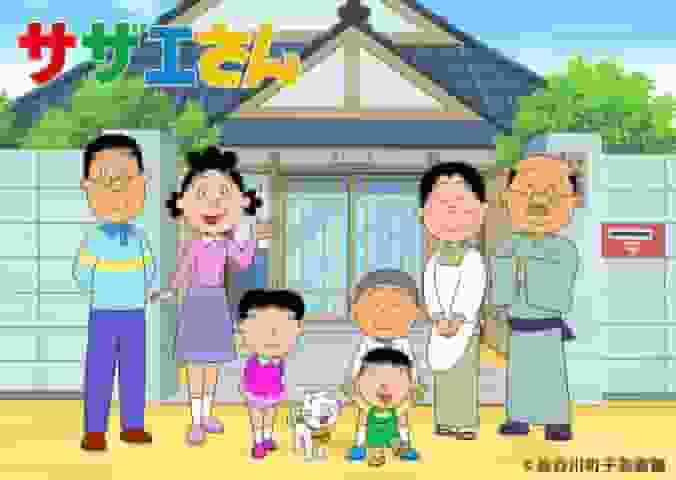Sazae-san: The charm of eternal family love and humor

Sazae-san: A timeless masterpiece that symbolizes Japanese anime cultureJapanese animation is unparalleled in the world in terms of its history and diversity. Among them, one work that has a particularly long history and is deeply loved by audiences is "Sazae-san." Since it began airing in 1969, this work has brought laughter and emotion to Japanese homes for over half a century, and can truly be said to symbolize Japanese anime culture. Overview"Sazae-san" is a TV anime series based on a four-panel comic strip by Machiko Hasegawa. The main character is a bright and energetic 24-year-old housewife, Sazae Fuguta. The series centers around her and depicts the daily life of the Isono family and those around them. It first aired on October 5, 1969, and is still broadcast every Sunday from 6:30 to 7:00 p.m. on Fuji TV. Even now, more than 50 years after its first broadcast, its popularity has not waned, and in 2013 it was recognized by the Guinness World Records as the "longest-running TV anime program." In addition, from 1975 to 1997, the show was rebroadcast every Tuesday from 7:00 to 7:30 p.m. as "Manga Masterpiece Theater Sazae-san," with a total of 1,190 episodes. This rebroadcast version used newly created opening and ending themes, giving viewers a fresh impression. Story and CharactersThe story of "Sazae-san" revolves around the Isono family. The main character, Sazae, has a bright and cheerful personality, and although she makes mistakes from time to time, she enjoys spending her days with her family and friends. Her husband, Fuguta Masuo, is a good-natured and slightly timid man, but he loves Sazae deeply. Sazae's father, Isono Namihei, is a stubborn but kind-hearted character with many hobbies but a jack of all trades, who warmly watches over his family. Her mother, Isono Fune, supports her family as a good wife and mother. Sazae's younger brother, Isono Katsuo, is in the fifth grade and is the most playful member of the Isono family. He is good with words and sometimes gets into trouble, but he also has a kind-hearted side. His younger sister, Isono Wakame, is in the third grade and is a kind-hearted, reliable and excellent student. Sazae and Masuo's son, Fuguta Tarao, is three years old and has a curious personality. Tama, the Isono family's pet cat, is a pure white male cat with a big bell as his trademark. Production and staffSazae-san is produced by Fuji Television and Eiken. It was written by Hasegawa Machiko, whose four-panel comic strips are the basis of the anime. Producers include Kubota Eiichi, Kono Yuichi, Watanabe Tsuneya, Keuchi Setsuo, Matsushita Yoko, and Tanaka Yoichi, while chief directors include Watanabe Yonehiko, Yamagishi Hiroshi, and Morita Hiromitsu. Chief animators include Keuchi Setsuo, Tsukikawa Hideshige, Katano Isao, Kunibo Makoto, and Nishisaka Akiko, while art directors include Ono Tatsuo, Kamezaki Tsunefumi, Kubo Haruhiko, Osumi Toshihiro, and Sato Hiroshi. Scriptwriters include Yukimuro Shunichi, Shiroyama Noboru, Tsuji Masaki, and Namie Yuji, while music is by Koshibe Nobuyoshi and Kono Tsuyoshi. castThe cast of "Sazae-san" has included many voice actors over the years. Sazae is voiced by Midori Kato, while Masao is voiced by Shinsuke Chikaishi, Hiroshi Masuoka, and Hideyuki Tanaka. Katsuo is voiced by Nobuyo Oyama, Kazue Takahashi, and Mina Tominaga, while Wakame is voiced by Yoshiko Yamamoto, Michiko Nomura, and Makoto Tsumura. Tara is voiced by Douko Takaya, and Namihei is voiced by Ichiro Nagai and Chafurin. Fune is voiced by Miyoko Asou and Yorie Terauchi. These voice actors bring the characters to life. Theme songs and musicThe theme songs of "Sazae-san" have been loved by many viewers. The opening theme "Sazae-san" was written by Haruo Hayashi, composed by Kyohei Tsutsumi, and sung by Yuko Uno. The ending theme "Sazae-san Ikka" was also written by Haruo Hayashi, composed by Kyohei Tsutsumi, and sung by Yuko Uno. Manga Masterpiece Theatre Sazae-san also has a wide variety of theme songs. The opening theme, "Sazae-san no Uta," was written by Yasutomi Yasugo, composed and arranged by Watanabe Chumei, and sung by Horie Mitsuko. The ending theme, "Akarui Sazae-san," was written by Eiken Co., Ltd., composed and arranged by Watanabe Chumei, and sung by Horie Mitsuko. In addition, various other theme songs have been produced to entertain viewers. Viewership and influenceSazae-san has very high ratings, reaching a peak of 39.4%. This is a very high figure for a Japanese TV anime program, proving its popularity. In addition, the style of broadcasting three episodes every week, with each episode featuring at least one original four-panel manga, continues to provide viewers with fresh surprises. In addition, the opening and ending themes, which change with the seasons, and the Sazae-san rock-paper-scissors game at the end of the show have also attracted attention and deepened communication with viewers. The combination of these elements has made "Sazae-san" a work that has deeply penetrated Japanese households and is loved by many people. Guinness World Records and 50th Anniversary of BroadcastIn 2013, "Sazae-san" was recognized by the Guinness World Records as the "longest-running animated television program." This was achieved more than 44 years after its broadcast began, and as it has continued to be broadcast since then, it is now a work with a history of over 50 years. In 2019, it celebrated its 50th anniversary, with commemorative events and special programs being broadcasted to look back on its history with viewers. Social impact and evaluation"Sazae-san" has had a major impact on Japanese society and culture. In particular, the storyline, which depicts family ties and the joys of everyday life, has resonated with many viewers, and has given viewers a new appreciation for the importance of family love and friendship. Hasegawa Machiko's four-panel comic strips are full of humor and warmth, and while they bring smiles to viewers' faces, they are also highly regarded for their deep insight, sometimes satirizing social issues. Furthermore, "Sazae-san" is an essential part of the history of Japanese television animation, and its production style and the way it communicated with viewers had a major influence on later anime works. In particular, the style of broadcasting three episodes per week and the opening and ending themes that changed with the seasons continued to provide fresh surprises to viewers and made it possible for the series to be broadcast for a long period of time. Communication with viewers"Sazae-san" is also a show that values communication with its viewers. In particular, the Sazae-san rock-paper-scissors game at the end of the show gained popularity as content that viewers could enjoy together. In addition, the opening and ending themes, which change with each season, allow viewers to feel the change of seasons and provide an opportunity to share the joys of everyday life. The combination of these elements has allowed "Sazae-san" to build a strong bond with its viewers and has supported its long-running broadcast. Future outlook"Sazae-san" is still on the air today, and its popularity shows no sign of waning. In particular, its emphasis on communication with viewers and its opening and ending themes that change with each season will surely continue to provide viewers with fresh surprises. Hasegawa Machiko's four-panel comic strips are also highly regarded for their deep insight, as they are full of humor and warmth, bringing smiles to viewers' faces, while also sometimes satirizing social issues. The combination of these elements means that "Sazae-san" will continue to penetrate deeply into Japanese households and remain a beloved work by many. Conclusion"Sazae-san" is an essential part of the history of Japanese television animation, and its production style and method of communication with viewers had a major influence on later anime works. In particular, the style of broadcasting three episodes per week and the opening and ending themes that change with each season continued to provide fresh surprises to viewers and made it possible for the show to be broadcast for such a long period of time. Furthermore, the show's emphasis on communication with viewers and its opening and ending themes that change with each season will no doubt continue to provide fresh surprises to viewers in the future. "Sazae-san" has penetrated deeply into Japanese households and will continue to be loved by many people. |
>>: The appeal and reputation of Moomin: A must-see classic anime for fans
Recommend
The appeal and reviews of "Chagama Ondo": A must-see for anime fans
Detailed evaluation and recommendation of Chagama...
Tom Holland was invited to star in the animated film Spider-Man: Into the Spider-Verse
According to Spider-Man: No Homecoming star Tom H...
Snowpiercer Season 2 releases new trailer, returns on January 25, 2021
The second season of the TV series "Snowpier...
"Gintama" "Final Training" will be released on June 17th and will usher in the real finale!
Gintama, the super popular manga that Sorachi Hid...
Square Enix to release Final Fantasy 9 animation for kids
In addition to Final Fantasy 16, Final Fantasy 7 ...
Spider-Man: Into the Spider-Verse 2: New Character Announced, the First Spider-Woman Debuts
According to The Hollywood Reporter, actress Issa...
"Silver Spoon": A moving story depicting the realistic youth and growth of an agricultural high school student
"Silver Spoon": A moving story about yo...
The appeal and reviews of "Salty Ray": A moving story and deep characters
"Salty Ray": A story of a girl torn bet...
Higurashi When They Cry Kai review: Into the depths of mystery and horror
"Higurashi When They Cry Kai": A story ...
Review of "The Executioner": A story of a girl torn between life and death
A comprehensive review and recommendation of The ...
The movie "Borderlands" may have a handsome Jack Easter egg at the end to pave the way for the sequel
Gearbox President Randy Pitchford has confirmed t...
CBS to launch modern drama series "Watson Postscript" with black actor playing Watson
CBS will launch a modern new scripted collection ...
Innovation is better than classics! A list of the best Japanese original animations since 2000
Although there are many well-known animations in ...
The appeal and evaluation of Arpegio of Blue Steel -Ars Nova-: New possibilities for maritime science fiction
The appeal and evaluation of "Arpeggio of Bl...
The Boys Season 3 Finale Preview: The Battle is Coming
The third season of Amazon's hit series "...









